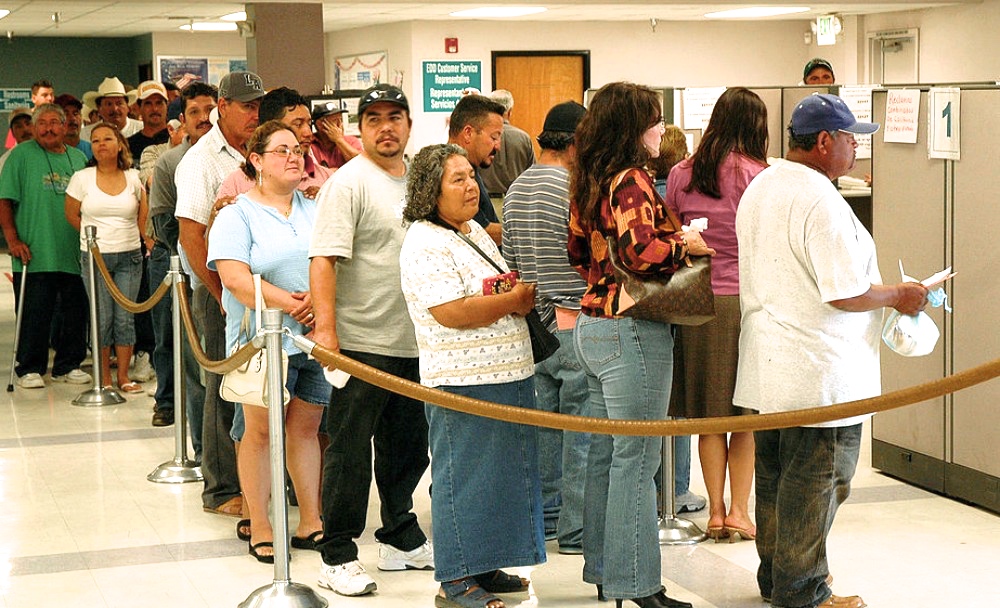
Americans are feeling the impoverishing effects of the shift from middle-income to low-income jobs. The disappearance — or, more accurately, downsizing — of living-wage jobs is documented by numerous reports that reveal the suddenness and the extent of this affront to middle America.
First, the Neoliberal Explanation: It’s Not Really Happening
Business writer Robert Samuelson calls the post-recession low-wage recovery a “myth.” To support his claim he cites a study from the Economic Policy Institute which, according to Samuelson, proves that “the economy’s employment profile — the split between high- and low-paying jobs — hasn’t changed much since the recession or, indeed, the turn of the century.”
But the EPI analysis is based on average wages within industries, rather than on the median, which reflects unequal growth. If the median had kept up with the average over the past 15 years, the current median wage would be $1/hour higher, or about $2,000 per year. The employment profile has actually changed a great deal since the year 2000.
There’s more. The EPI analyst claims that “jobs are being added relatively in proportion to their share.” But she only considers one year’s data, after much of the damage had already been done. Even so, the EPI figures show that the percentage of middle-wage jobs added in 2014 was 6.3 percent less than the overall percentage of middle-wage jobs (42.7% to 40%) — a rather dramatic change for a single year.
The Painful Evidence: Middle Class Jobs Are Disappearing
The Wall Street Journal, reporting on a Georgetown University study, concludes that “many middle-wage occupations, those with average earnings between $32,000 and $53,000, have collapsed.” Collapsed. High-wage occupations in technology, medicine, and finance are booming, and so are low-wage occupations in food service, retail, and personal care. But middle-income positions are fading away. The only one of the eight fastest-growing occupations that pays over $32,000 per year is nursing.
Manufacturing, once the backbone of mid-level employment, continued to decline in 2015. The Bureau of Labor Statistics determined that 18 percent of all displaced workers in 2011-13 were in manufacturing.
The evidence keeps accumulating. A US Mayors study found that ‘recovery’ jobs pay 23 percent less than the jobs they replaced. The National Employment Law Project estimates that low-wage jobs accounted for 22 percent of job losses but 44 percent of subsequent job gains. Business Insider, Huffington Post, and the Wall Street Journal all concur: the unemployment rate is remaining low because of low-paying jobs.
About That Unemployment Rate
The true unemployment rate, if discouraged and part-time workers are included, is doublethat of the official rate. It’s probably much worse. Alliance for a Just Society estimates that there are 7 job seekers for every $15/hour job opening.
No, This is Not Your 19th Century Textile Economy
Some analysts use simplistic comparisons with ages-old economies to assure us that everyone will eventually get a good job. The Atlantic spouts: “The job market defied doomsayers in those earlier times, and according to the most frequently reported jobs numbers, it has so far done the same in our own time.” Economist Dean Baker rants about robots: “Large numbers of elite thinkers are running around terrified that we will have millions of people who have no work because the robots have eliminated the need for their labor…We have been seeing workers displaced by technology for centuries, this is what productivity growth is.”
But there are two differences now: (1) In the past technology created middle-class jobs, manufacturing jobs, white-collar jobs, HIGHER-PAYING jobs. Now the jobs are at the extremes, either high-level or low-level, with tech-related jobs on the higher end and service-related jobs on the lower end. And (2) Globalization has outsourced middle-income jobs, not only from rich to poor countries, but also from one developing nation to another, as, for example, from China to Vietnam.
The World Economic Forum suggests that we’re “on the cusp of a Fourth Industrial Revolution” in which “smart systems” in our homes, factories, farms, and entire cities will help get our work done.
We can’t wait around for a 19th-century recovery. We need a new paradigm. We need guaranteed jobs. We need a guaranteed income to ensure that the benefits of 60 years of U.S. prosperity go to all Americans, not just to the few who know how to redistribute the nation’s wealth.
3 WAYS TO SHOW YOUR SUPPORT
- Log in to post comments
















